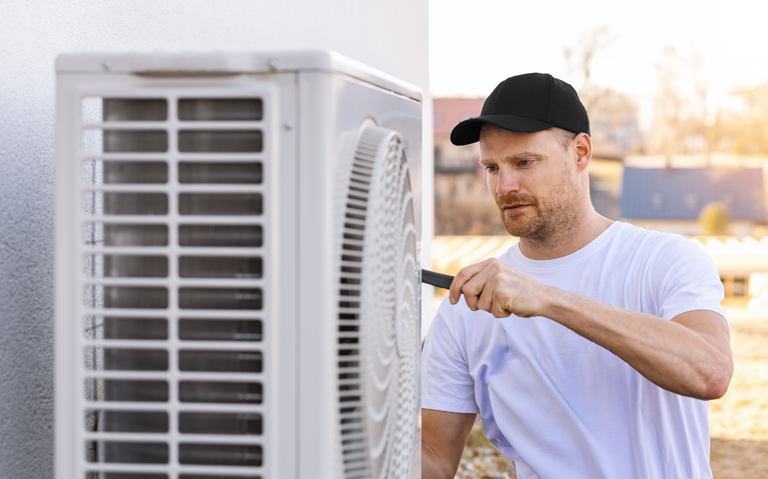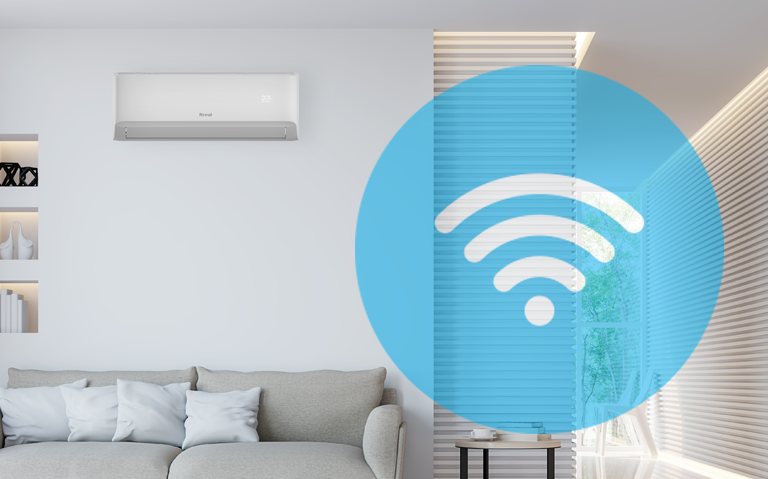Based on the Jan 2025 data from Consumer, your hourly heat pump cost should be around 26c. Actual costs depend on:
- Heating efficiency (COP) – aim for 3.0 or higher
- Cooling efficiency (EER) – aim for 3.0 or higher
- Your power company’s rates
- Room size and insulation quality
- Usage patterns and temperature settings
To calculate your hourly running cost:
For heating: (kW capacity ÷ COP) × power rate
For cooling: (kW capacity ÷ EER) × power rate
While heat pumps are an efficient way to stay warm, it’s important to keep an eye on energy consumption, especially during the colder months, to avoid unexpectedly high bills.
Explore our range of home heating at Rinnai, or keep reading to learn more about heat pump costs.

In this article…
- Do heat pumps use a lot of electricity?
- What is the downside to a heat pump?
- Heat pump cost FAQs
- How much does it cost to run a heat pump per hour in NZ?
- Is running a heat pump expensive in winter?
- How much does it cost to install a heat pump in NZ?
- Are heat pumps cheaper to run than electric heaters?
- What factors affect the cost of running a heat pump?
- Is it better to leave a heat pump on all day or turn it off?
- How much does it cost to cool your home with a heat pump in summer?
- How can I reduce the running costs of my heat pump?
Do heat pumps use a lot of electricity?
No, heat pumps are highly efficient when it comes to electricity usage.
Heat pump electricity use when heating
Heat pumps use electricity to shift ambient heat from the air outdoors into your home producing approximately 3-5kW of heat energy for every 1kW of electricity used.
According to Consumer, the running cost of a heat pump in heating mode in winter ranges around 26c per kilowatt-hour (kWh) of heat produced.
In comparison, a traditional electric heater can cost between 19 and 40 cents per unit of heat.
Remember: For every degree you increase the heating and cooling settings, your energy consumption rises by about 5% to 10%.

Source: Consumer NZ https://www.consumer.org.nz/articles/home-heating-costs
Heat pump electricity use for cooling
Similarly, using a heat pump to cool down on hot, humid evenings and enhance your sleep quality doesn’t have to be an expensive way to enjoy a restful night.
The cost of operating a heat pump in cooling mode, much like heating, depends on various factors like your home’s size, condition, orientation, insulation, and the efficiency of the heat pump model you choose.
Cooling your home with a heat pump typically ranges from $60 to $120 per month. However, you can save significantly by using the fan mode, which costs just around 5 cents per hour.
For more efficient cooling across multiple rooms, consider a Multi Split Heat Pump, perfect for homes with varying temperature needs.
Follow these tips to use your heat pump efficiently in summer:
- Use the dehumidifying setting in summer to combat heat effectively
- Avoid setting the temperature to the lowest level to cool the space faster – it makes the heat pump work harder and uses more power
- Set the heat pump temperature between 18–21°C for optimal comfort, lower energy consumption, and better sleep quality.

Is it cheaper to leave my heat pump running all day and night?
Yes, leaving your system on to heat your home can often be the wiser choice instead of turning it off and on again, as it uses less energy to maintain a room’s temperature but more energy to change it.
One of the best things about heat pumps is that they have been specifically designed to be as energy-efficient as possible when running for long periods.
However, if you’re leaving the room for more than a couple of hours, it’s best to turn your system off.
Keeping your heat pump on when it’s not needed can lead to even higher power bills and cause your system to break down faster than it should.
High Wall Heat Pumps are an excellent choice for homes seeking space-efficient, reliable heating and cooling solutions.

If you’d like to return to a perfectly warm home, instead of leaving your heat pump on all day, you can set the programmable timer instead! These work by turning your heat pump on or off at pre-determined times chosen by you.
Rinnai Heat Pumps also come with a Wi-Fi phone app, allowing you to adjust your heat pump settings from anywhere, at any time.
If you aren’t sure which Rinnai Heat Pump best suits you, we’re here to help.
What is the downside to a heat pump?
Heat pumps are an excellent choice for maintaining a comfortable home temperature throughout the year, as they provide both heating in winter and cooling in summer.
However, there are a few aspects to consider when using heat pumps to ensure optimal performance and cost efficiency.

- Choose energy-efficient heat pump models suited to the size and layout of your space to avoid high energy bills
- Understand that defrost mode may temporarily stop warm air during colder weather, as the heat pump clears ice buildup on the outdoor coil to maintain efficiency
- Budget for ongoing maintenance costs, which should average around $100 per year with regular filter cleaning
Find the most suitable heat pump options for your home with Rinnai’s heat pump calculator.
By selecting the right model and performing regular maintenance, you can enjoy the benefits of a heat pump while minimising any downsides associated with its usage.
Heat Pump Cost FAQs
How much does it cost to run a heat pump per hour in NZ?
The running cost of a heat pump is around 26 cents per kilowatt-hour (kWh) of heat produced, depending on factors like your electricity provider, home size, insulation, and heat pump efficiency.
Is running a heat pump expensive in winter?
No, heat pumps are very efficient, but it also depends on reasonable usage. In winter, they produce 3-5kW of heat for every 1kW of electricity used, making them far cheaper than traditional electric heaters.
How much does it cost to install a heat pump in NZ?
As a general rule, High Wall Heat Pumps cost between $2,000 and $4,000 inclusive of installation. Ducted ‘Whole Home’ systems range from around $8,000 to $15,000, also including installation costs. The easiest way to get a better idea of the cost of installing a heat pump in your home is to find your nearest stockist or installer and ask for a quote.
Are heat pumps cheaper to run than electric heaters?
Yes. Heat pumps cost around 26c/kWh of heat, while traditional electric heaters can cost 19-40 c/kWh, making heat pumps a far more cost-effective choice.
What factors affect the cost of running a heat pump?
Costs depend on home size, insulation, heat pump model, and usage habits. Efficient models and good insulation significantly lower running costs.
Is it better to leave a heat pump on all day or turn it off?
For short absences, leaving it on is efficient. For longer periods (2+ hours), it’s best to turn it off and use a timer to warm your home before returning.
How much does it cost to cool your home with a heat pump in summer?
Cooling typically costs $60 to $120 per month, depending on usage. Switching to fan mode can reduce costs to as little as 5 cents per hour.
How can I reduce the running costs of my heat pump?
Set temperatures between 18-21°C, clean filters regularly, use timers, and ensure your home is well insulated to maximize efficiency and savings.





















